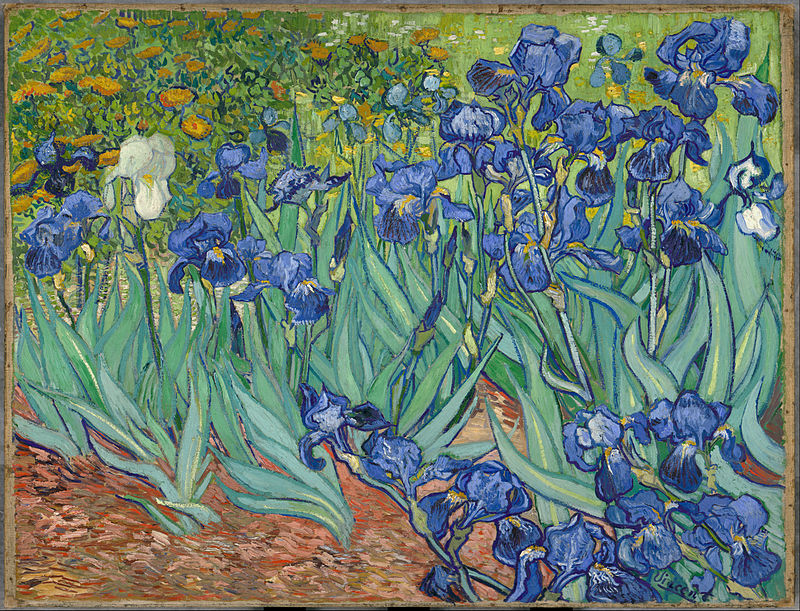
‘The field – basho – is “literally nothing, it is not a being at all,” since as a universal, “the field has absolutely none of the characteristics applying to the parts … It is the place, given as an intuition, as a whole, a gestalt, which knowing, saying, analysing, and defining try to specify. They all distort the original unity, take it apart, dissect it, re-structure it for specific purposes. So long as such partial and ripped-out-of-context specification is seen as having its place in its field, no damage is done, and indeed something is actually to be gained … But such advantage is epistemologically sound if, and only if, one returns to the source intuition again and again to re-structure it anew” (Robert E Carter, The Nothingness Beyond God p 32).
The problem with Aristotle – and Western thought as a result – is that “in a real sense, Aristotle ends up conflating the essence of a thing with its individual existence.” (Jaakko Hintikka, quoted by Robert Carter, 22). He conflates the fact “that the thing is” and “what it is,” with the result that the “that it is” of its “lived” particular existence is concealed by “what it is,” its “name,” what it stands for in the abstract interpretation of how reality works. For those familiar with Heidegger, it is akin to what he called the West’s “forgetting of Being.” This can be clearly observed in the sciences, where “most scholars, even the physicist and sociologist, work from mathematical signs and documents, and not directly from experience. Observations are to be written down, turned into data, before they can be accurately handled. And there is hardly a whiff of doubt entertained about whether the translation from observation to paper, or to symbols on a blackboard, adequately captures the richness of the immediate. Quite the contrary, the common assumption is that it is not genuine data until it is verbalized, organized, or rendered precise through translation to yet more precise formulae” (Carter, 20). How do you reconnect with the concrete reality of the particular now hidden behind the screen of abstract concepts? Aristotle stated: “To know a thing is to name it, and to name it is to attach one or usually more universal predicates to it. Not only is the fixed within the flow alone knowable, but the universal in the individual as well. There is no place for the flow to be known as flow, nor the individual as individual. These defects Nishida set about to repair” (Carter, 25-26).
“To say that one’s glass of wine is red … is to have already ‘bought into’ the system of wines and their types”
The reason why Nishida started out with a focus on a recovery of “pure experience,” which we must understand as a Western analogue of the Zen state of no-mind, are now becoming clear. From that standpoint, Nishida took a fresh look at the link between the grammatical subject and predicate. These are two universal concepts, two abstractions. Carter writes: “What … is the link between the grammatical subject and predicate? Nishida’s ‘Copernican revolution,’ to so name it, is in hypothesizing that the proper question is not ‘how are these two universal concepts unified or linked?’ but “how can such specification of the wider (more general) universal occur?’” The initial intuition already contains, at least implicitly, the structure of the relationship. To say that one’s glass of wine is red, then, is to have already ‘bought into’ the system of wines and their types” (Carter, 27).

Just as, in the Inquiry, he stated that “pure experience includes thinking” (17), Nishida finds that the initial intuition, which he calls “intellectual intuition,” includes “the structure of the relationship,” that is, that the color red necessarily arises at the same time as the universal called “color.” “If red were the only color, it would not appear to us as such, because for it to do so there must be colors that are not red. Moreover, for one quality to be compared with and distinguished from another, both qualities must be fundamentally identical; two things totally different with no point in common cannot be compared and distinguished. If all things are established through such opposition, then there must be a certain unifying reality concealed at their base” (Nishida, 56). This unity concealed at the base of all colors is the universal called “color.” So the color red and the universal called “color” are intuited in pure experience. The word “system” – instead of “universal” – used by Carter refers to the fact that when things are given “names,” they are actually “enveloped” by a multiplicity of universals, not just one – here the different types of wines, the different brands for each type, the various vintages, the many grape varieties used, the winemaking styles traditional to various regions, etc.
So, Carter continues: “What is primary in the judgment “red is a color,” is not the grammatical subject … the real subject of the sentence “red is a color” is not “red,” nor even the grammatical predicate “color,” but the system of colors itself. To have a concept of “red” is already to have a concept of colors. Of course, the system, like “color” itself, has no color” (Carter, 27). As all things can only appear in contrast with each other within pairs of opposites, the concept of red is intuited at the same time as the concept of color. “Color is a ‘field’ in which specifications arise … A field-theory takes the background as the real foreground, the real subject. So, in a field of energy, focuses or concentrations of energy are really specifications of the whole, just as in a Zen rock garden, a particular shape simply calls attention to the undifferentiated expanse on which it sits, or better, out of which it arises … The field itself, however, is not all colors … but that which supports, or even generates, colors … It is an intuition, a given of experience or conception of which individual instances are but partial articulations” (Carter, 29).

“Emptiness is I.”
Nishida’s articulation of his field-theory was achieved not through theoretical thinking, but, as he repeatedly reminds us, through pure experience. It is a given of experience in the sense of pure experience or no-mind. One cannot help hearing in the background of the discussion the famous formula of the Heart Sutra: “Form is emptiness, emptiness is form.” “Form is emptiness” refers to the discussion about the concealment of the concrete particular – “that it is” – behind the veil of the empty universal used as predicate to say what the thing is. “Emptiness is form” refers to the field – basho – of this universal used as predicate, which is empty, and is intuited at the same time as the thing, so rises up in experience as the ground of the thing, that which grounds its presence. Masao Abe, likewise, wrote: “It is not that “I am empty,” but rather that “Emptiness is I.” It is not that I, as an ego-self am empty, but that the emptiness of basho is my “true self.”
Eager to stick to Aristotelian language, Nishida “speaks of this as his logic of predicates, to contrast it with Aristotle’s logic of the subject.” Carter finds this awkward because basho “is not the actual grammatical predicate … It would be better to use his other designation, however – the logic of place, for … the place/system/field houses or grounds both the grammatical subject and predicate. Basho, then, is that which is neither predicated of, nor present in, a subject, nor even the grammatical subject, but that which grounds both, and out of which both arise as specifications or determinations” (Carter, 31).
From anatman/sunyata to wu/mu
As absence of own being, anatman remained a metaphysical entity in the sense that it was precisely a “me-ontology,” a lack of “on” (Greek for `”being”). It was neither an essence nor a substance, and it had no independent existence. Nagarjuna had extended this lack of being from the human self to all dharmas (things), and defined sunyata as co-dependent origination, whereby all things arise as pairs of opposites. In China, however, sunyata came to be understood through Daoism’s wu, its own encounter with nothingness, which was experiential rather than metaphysical.

For the Chinese, and especially the Daoists, nothingness – wu – was a concrete experience, described not as a (negative) lack of being, but as the background to a (positive) conception of reality as change, with the life force generating forms as it flows through “all things under Heaven.” Though “wu” (Jp “mu“) and “sunyata” never entirely merged, this Chinese reliance on concrete, embodied, experience allowed the masters of the Chan (Zen) School to switch their standpoint from that of the Buddhist truth seeker still immersed in dualistic ordinary consciousness trying to gain liberation through enlightenment, to that of realised masters, who could speak directly from their experience of the enlightened vision. It is that enlightened vision that Nishida takes as his starting point, and which he first assimilates to the empiricist inquiries described by James, Bergson, and later the phenomenologists. In a sense, the Copernican revolution Nishida is credited with is really a repeat of that which took place when Chan masters started to teach from their experience of enlightenment. As they did, though, they also provided the Daoist experience of nothingness with more sophisticated meditational techniques as well as a stronger philosophical framework. Nishida, once again coming back to the enlightened vision of no-mind, sought to articulate what he saw using the language of Western philosophy which he regarded as the best vehicle to ensure the survival of Zen teachings insofar as they give access to the true nature of reality. This is how he arrived at this notion of “field” or “place,” which was suggested to him by the Aristotelian concepts of hypokeimenon and khôra. What this allowed him to do is to turn the perspective around. Instead of saying “I see the world in front of me,” he will say “the world is inside me,” and as inside me, as constituting what I call my consciousness, the world is actually both apprehended and re-shaped by me, as well as all other humans, as we co-express it. The metaphor of the field will be further developed by Nishitani in Religion and Nothingness, where he contrasts the “field of emptiness” – Nishida’s basho – and the “field of consciousness,” – Nishida’s “object logic” – the former being the view from the enlightened standpoint of no-self, the latter the view from ordinary, objective consciousness where we see ourselves and objects as solid entities. We could say that the metaphor of the place or field provides a spatial image that moves us away from our unexamined presupposition of a substantial physical substratum.
Basho as both an (abstract) epistemological universal and a (concrete) embodied intuition
For Nishida, the field – basho – is “literally nothing, it is not a being at all,” since as a universal, “the field has absolutely none of the characteristics applying to the parts … It is the place, given as an intuition, as a whole, a gestalt, which knowing, saying, analysing, and defining try to specify. They all distort the original unity, take it apart, dissect it, re-structure it for specific purposes. So long as such partial and ripped-out-of-context specification is seen as having its place in its field, no damage is done, and indeed something is actually to be gained … But such advantage is epistemologically sound if, and only if, one returns to the source intuition again and again to re-structure it anew” (Carter, 32). The concept of basho allowed Nishida to refine his early assertions that “pure experience includes thinking,” and that “thinking and intuition, … when we view them as facts of consciousness we realise that they are the same kind of activity” (Nishida, 31). As a field of nothingness, basho allows thoughts to arise, an act which from the side of the individual consciousness is referred to as “intellectual intuition,” but these conceptual bits cut out from pure experience do no damage to the field, since the field is nothingness, just as the pictures or words “displayed” on a screen can do no damage to the screen, as you can discontinue the display and restore the screen to a blank state for further displays. Provided you likewise “question” the conceptual representation of reality and return to “pure experience” again and again, “naming” in order to know, and “thinking” in order to understand, are fine. In fact they are necessary to deal with practical life. When students of Buddhism are warned against thinking, they often misunderstand this warning as meaning that thinking is “bad” and a hindrance to enlightenment. Nishida asserts that thinking is a natural activity of consciousness which it is futile to try to stop. The problem is attachment to specific conceptual formulations, and the warning against thinking is in fact the equivalent of Nishida’s invitation to return to “the state of experience just as it is without the least addition of deliberative discrimination.” It is only an exercise in returning to concrete reality to “restructure it anew.”
The self does not see reality outside, it is the field out of which reality expresses itself
As Westerners, we see the world as emerging as a coherent order from a chaotic substratum, according to a process of naming which seems to take place in front of us, so “outside of us.” When told that this substratum is not substantial, but nothingness, we may come to see the world as emerging out of empty space in front of ourselves. But this is not what Nishida means. Along with the East, Nishida sees reality as an experienced grasp of life as it unfolds in the present moment. The self which experiences reality does not “see” that reality, but, in a sense, “creates it,” or rather, is the place (basho) where the formless self-expresses as the forms of reality. “Basho is the deep self of pure experience … which is a manifestation of that unity which lies at our depths” (Carter, Encounter with Enlightenment: A Study of Japanese Ethics, 153).
Sources:
Jaakko Hintikka, “The Varieties of Being in Aristotle” in Knuutilla and Hintikka eds, Logic of Being quoted by Robert E Carter, The Nothingness Beyond God, page 22
Robert E Carter, The Nothingness Beyond God – An Introduction to the Philosophy of Nishida Kitaro (1997)
Nishida Kitaro, Inquiry into the Good (1911)
Robert E Carter, Encounter with Enlightenment: A Study of Japanese Ethics (2001)
Masao Abe, Zen and Western Thought (1985)

